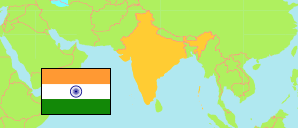
Pakur
District in Jharkhand (India)
Contents: Population
The population development of Pakur as well as related information and services (Wikipedia, Google, images).
| Name | Status | Population Census 1991-03-01 | Population Census 2001-03-01 | Population Census 2011-03-01 | |||||||||||||||
|---|---|---|---|---|---|---|---|---|---|---|---|---|---|---|---|---|---|---|---|
| Pakur | District | 564,253 | 701,664 | 900,422 | |||||||||||||||
Pakur 900,422 Population [2011] – Census 1,813 km² Area 496.8/km² Population Density [2011] 2.5% Annual Population Change [2001 → 2011] | |||||||||||||||||||
| Bhārat [India] | Republic | 846,387,888 | 1,028,737,436 | 1,210,854,977 | |||||||||||||||
Source: Office of the Registrar General and Census Commissioner, Delimitation Commission of India.
Explanation: Districts in the boundaries of 2023. Population figures of new delimitated districts are computed by using subdistricts or villages in the boundaries of 2011. Thus, slight deviatiations from the actual population are possible in some cases. Area figures of new delimitated districts are derived from geospatial data.
Further information about the population structure:
| Gender (C 2011) | |
|---|---|
| males | 452,661 |
| females | 447,761 |
| Urbanization (C 2011) | |
|---|---|
| rural | 832,910 |
| urban | 67,512 |
| Population Group (C 2011) | |
|---|---|
| »Scheduled Castes« | 28,469 |
| »Scheduled Tribes« | 379,054 |
| not indigenous | 492,899 |
| Literacy (A7+) (C 2011) | |
|---|---|
| yes | 352,881 |
| no | 369,918 |
| Age Groups (C 2011) | |
|---|---|
| 0-6 years | 177,623 |
| 7+ years | 722,799 |
